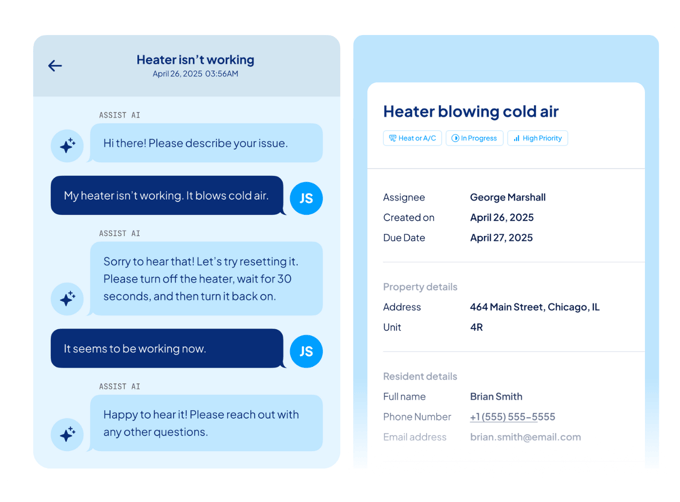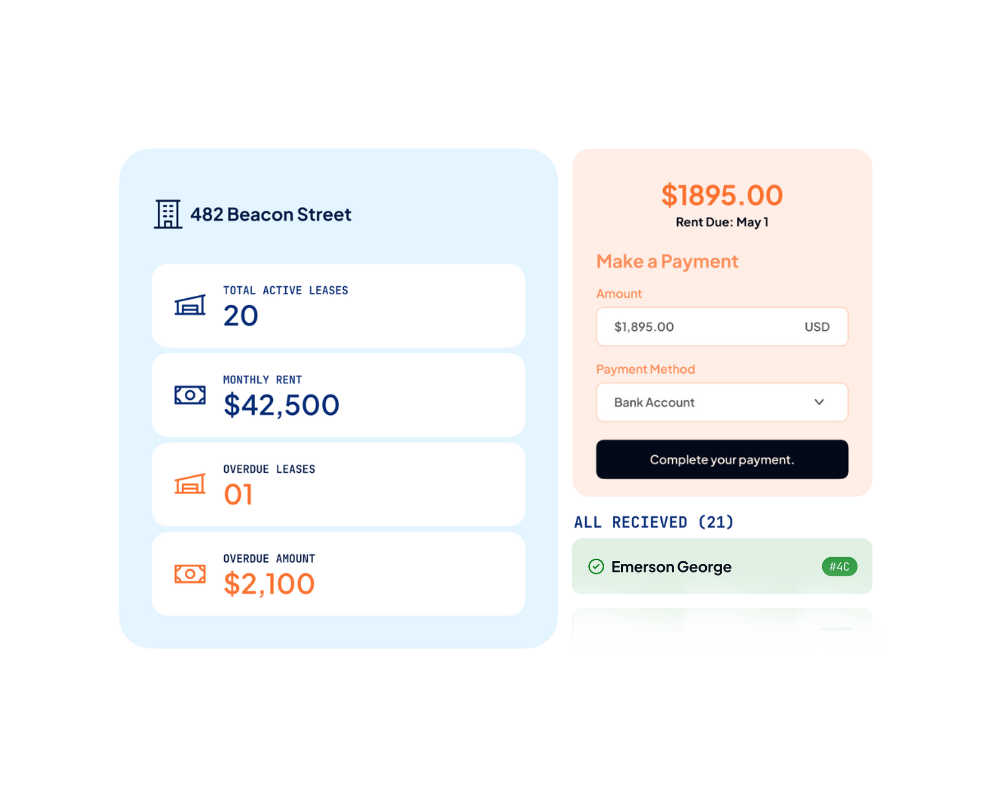Manual Rent Collection Is Costing You: Here’s the Data.
Manual payments may be costing more than you realize. Discover the overlooked costs of paper checks, from increased fraud risk to slower cash flow.
Is your multifamily ops team buried in manual tasks? Learn how automation saves time, cuts costs, and improves the resident experience.
Many multifamily operations teams are stretched thin. In a National Apartment Association survey, 14.3% struggled with maintaining proper staffing levels, and 13.2% struggled with managing their workload. Plus, a full 79% said their job had a negative impact on their mental health. When teams are running on empty, residents can feel it, and the strain may affect the resident experience and retention.
The good news? Your ops team can reclaim a significant amount of time by embracing automation and AI tools. Property management companies saved roughly 61 hours of manual work last year by automating operations. And teams can likely save more because they’re still spending an average of 95 hours per month on manual processes.
This guide highlights key tasks property managers do manually and explains how to automate them to recover time, reduce operational costs, and improve the resident experience and your portfolio’s performance.
Fast, efficient maintenance matters even more for residents and retention than many property managers realize. In a resident experience study, when property managers were asked to rank poor maintenance service on a list of reasons renters chose not to renew their leases, they put it 12th. Residents, on the other hand, said poor maintenance service was the second most likely reason they chose not to renew, only after cost.
Nearly half (44%) of renters in the same study ranked maintenance repairs as the first or second most important aspect of the resident experience. Plus, in the 2024 Grace Hill and NMHC Renter Preferences Survey, 52% of renters said maintenance-free living was their primary reason for renting.
Ultimately, fast and efficient maintenance is critical for multifamily success. Yet, many ops teams still rely on inefficient manual processes, such as:
These tasks add up. Property managers spend 42 hours per month manually managing back-office operations, including maintenance requests. Unfortunately, managing maintenance manually can lead to backlogs, errors, miscommunication, and limited oversight of maintenance tasks.
Automating maintenance requests can save teams hours, speed up resolution timelines, and reduce errors. Maintenance automation may also improve resident experience and help boost renewals because the majority of residents actually prefer automation over talking to a human when it comes to submitting maintenance requests (57%) and getting maintenance status updates (55%).
What could automated maintenance management look like for your portfolio? To get a better idea, let’s look at ApartmentAdvisor ASSIST. With this system, residents use the ASSIST app’s user-friendly, conversational interface to report maintenance issues anytime, 24/7.
The system responds instantly to residents’ queries via text, asking relevant questions to better understand their problem. For example, if a resident reports a power outlet isn’t working, the system may ask if the lights are working in the affected area and whether any other outlets are having an issue.
When possible, the system guides residents through a quick fix. For example, it may help the resident reset an outlet or tripped circuit breaker without needing assistance from a technician.

Because skilled engineers thoroughly train ASSIST using accurate, up-to-date sources, including maintenance manuals and local community knowledge bases, it has an exceptional track record of providing reliable information.
For more complex issues, the system determines priority and escalates tickets to maintenance technicians accordingly. The system also helps technicians organize their work orders and makes it easy for residents to track their requests from initial inquiry through resolution, so they never need to wonder about status updates.
As you can see, an AI-powered tool like ASSIST can offer your residents around-the-clock service, faster response times, and real-time updates and communication to improve the resident experience.
Chances are, your ops team spends a lot of time on tasks related to leasing. In total, property managers spend 53 hours per month on resident operations, including managing leasing.
If you’re still using manual processes, your team may be spending more time than they need to. A quarter (25%) of property managers manage leasing completely manually, which can include time-consuming tasks such as:
When your onsite team handles all these tasks manually, it can slow down leasing cycles, extend vacancy time, and increase errors. Screening renters manually can put you at a bigger risk for rental application fraud, which increased 71% last year. At the same time, manual operations can have a big impact on the resident experience because they pull staff time away from areas where residents prefer human interaction.
For example, 76% of residents prefer human interaction for the move-in process, which can set the tone for positive resident relationships down the line. Residents who report an extremely or somewhat positive move-in process are twice as likely to renew their leases at the end of their leasing term. If your team’s too busy managing rote manual tasks to devote time to the move-in process, your retention rate could suffer.
Automating leasing can help your team rent units faster, cut down on vacancy time, and improve the resident experience. Research suggests many residents want to take care of some leasing tasks by themselves digitally. For example, 72% want to take community surveys via digital tools, and 46% want to renew their lease via digital tools.
What could leasing automation look like for your portfolio? With a tool like ApartmentAdvisor ASSIST, you can access an all-in-one platform to help you market and syndicate listings, engage and qualify leads, schedule tours, manage applications, and sign leases.
ASSIST’s pricing tool uses property information and real-time market data to provide a range of pricing recommendations. If you want to maximize cash flow, you can choose the Premium Rate. But if you’d prefer to prioritize a quick turnaround, you can opt for the Fast Lease rate. The system also allows you to syndicate listings across major rental sites, so you can reach a wide market without manual effort.
When prospective renters reach out, ASSIST’s conversational AI agent responds instantly 24/7 across multiple channels, so leads never slip through the cracks. The system pre-qualifies prospects to help you find the best renters for your properties.

Prospects can use the system to book their own online tours, so your team doesn’t need to worry about the back and forth of scheduling. And once prospects take a tour, the system makes it easy to fill out a rental application online. It also integrates screening tools to streamline credit and background checks and reduce your risk of rental application fraud.
Finally, when it’s time to sign the lease, the system automates the generation of the lease and facilitates digital signatures. Then it securely stores the document in your PMS.
With an AI-powered system like ASSIST, your leasing team can save considerable time while improving the resident experience.
If your team manages payment collection manually, you’re not alone. Nearly half (44%) of rent payments are still made using paper-based methods. Your team may be spending a lot of time on tasks such as:
In addition to increasing manual work, paper-based payments such as checks and money orders can slow down cash flow. Plus, paper payments carry a higher risk of fraud than secure digital portals, which can cost you both time and money. Check fraud is on the rise: 90% of bankers said their institution experienced higher levels of fraudulent check-writing last year.
Plus, while many businesses rely on checks because they think they’re free or inexpensive to process, they have hidden costs, including time, labor, and losses due to fraud. A single paper-based payment can cost $3 to $10, according to one analysis.
Automated payment collection and processing can save considerable time, improve cash flow, and reduce the risk of check fraud. It can also cut costs. Automated Clearing House (ACH) transfers (bank-to-bank payments such as direct deposits) typically cost between $0.20 and $1.50 per transaction, making them a low-cost alternative to paper payments. Plus, automated payments can improve the resident experience because 69% of residents prefer to pay rent digitally rather than via human interaction.
What could payment automation look like for your portfolio? ApartmentAdvisor ASSIST offers a single platform for seamless rent collection, vendor payments management, and financial tracking.
The system automatically sends payment reminders to residents to help reduce missed or late payments. Residents simply log on to the secure ASSIST app to make payments via ACH transfer or credit card. While they’re there, they can see their outstanding balances and payment history.

On the management side, your team uses an intuitive dashboard to track which residents have paid, monitor balances, and generate reports. The platform supports vendor payments, so your team can view all your incoming rent and outgoing vendor payments without needing to switch tools.
Your team can stop chasing down paper checks and updating manual logs. With a tool like ASSIST, payment collection is simple, automatic, and secure.
If you’re still relying on manual processes for managing maintenance, leasing, or payments, they may be draining your teams’ time, creating delays, and hurting your overall performance.
Are you looking for an all-in-one automation platform to help you fill units faster, reduce your team’s workload, and streamline rent collection? ApartmentAdvisor ASSIST combines maintenance, leasing, and payments in one system to improve efficiency, enhance the resident experience, and boost performance. Schedule a quick demo to see how ASSIST can drive results across your portfolio.
Manual payments may be costing more than you realize. Discover the overlooked costs of paper checks, from increased fraud risk to slower cash flow.
Concerned about occupancy, compliance, and rising costs? Discover how AI & automation helps multifamily owners stay efficient, competitive, and...
Recently, one of our ASSIST customers made a small preventative maintenance change that led to more than a 10x return on investment.
Stay up to date with all our new blog posts for multifamily owners.